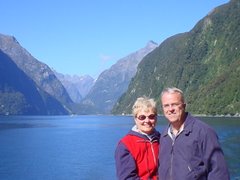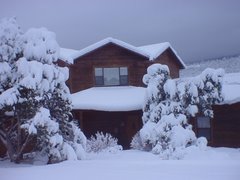Day 1-Beijing
Hutongs are clusters of four houses organized around a common courtyard, butted up against other hutongs, with narrow alleys winding among and around the hutongs. For the most part, the buildings are constructed of gray bricks or blocks. Gives the feeling of a village tucked away in a city of 13.5 million people. As George told us, living in a hutong neighborhood is a step up from the high-rise apartments that so many people live in.
Next stop a silk factory, specializing in producing silk quilts. It’s amazing how they extract the fiber from cocoons, spin, shape, and stretch it and produce all sorts of things.
One wall display showed several photos of the Chinese leader greeting various heads of state, all feeling a little uncomfortable, I think, in the same ceremonial silk jacket.
 | ||||
| Miss me yet? |
 |
| Still in charge? |
Watching Chinese city traffic is fun. Here a bicyclist pedals along apparently oblivious to the bus bearing down on her. Just a few minutes before there was another bicyclist heading the opposite direction, meeting an oncoming bus in about this same location. The Tiananmen Square picture of the lone protestor standing in the way of a tank popped into my mind. The bus stopped – turned out that this location is a bus stop – and the cyclist veered to his right toward the oncoming traffic (more than in this scene - I would have headed for the curb) and kept going. Beijing has traffic signals – I recall that the cities we visited four years ago had few if any – but still the scenes at major intersections are pretty chaotic. I recall reading an article not long ago to the effect that four-way stop signs do a remarkable job of inspiring self-regulated, altruistic behavior – Do unto others, … .
Lunch stop was at a Dai restaurant. Wikipedia says that the Dai people are one of 52 officially recognized ethnic groups in China. They are closely related to the Thai of Thailand. Good food plus dancing girls.
George told us that the permanent population of Beijing is 13.5 million and the number of total occupants on a given day is about 18 million. There are 4.5 million cars, plus every variety of scooter and pedaled conveyances. This can make for massive congestion, but we haven’t seen that yet. In fact, the neighborhood around our Holiday Inn seems fairly quiet, all things considered. Here's a combination motor bike/SUV.
After our Dai lunch, Beijing Day 1 continued with a visit to Tiananmen Square and the Forbidden City.
Incidentally, Jeff and Valerie are blogging our trip at: http://youbelong.net/pages/htmlos/ybnet/site.html?site=easterling. You can see more pictures there and get the parents’ perspective on this journey.
Tiananmen Square
From website: http://www.bookrags.com/tandf/tiananmen-square-tf/
Across the more than 440,000 square metres (100 acres) of cement expanse and among the monumental edifices of Chinese socialist neuesattlichkeit, hundreds of tourists and city residents saunter; three-wheeled bicycle peddlers hawk their wares; anticipatory lines of spectators are seated around the northern core of the square for the start of the evening flag ceremony; friends jostle to have their photographs taken against the backdrop of Chairman Mao’s portrait; multicoloured dragon and fish kites extend upward above the yellow glazed tile double-eaves of the rostrum at the Gate of Heavenly Peace (Tiananmen). This is where on 1 October 1949 Mao Zedong proclaimed the founding of the People’s Republic and on 18 August 1966 reviewed more than a million Red Guards, and, urging them on with chants of ‘zaofan youyi’ (to rebel is justified), launched the ten-year civil war against the Chinese Communist Party known as the Great Proletarian Cultural Revolution.
George said that this is the largest city square center in the world. It can hold half a million people. He never brought up the suppression of the democracy demonstrators there in 1989 and I doubt that anyone asked him about that history. Some scenes:
The building above is part of the Imperial Palace complex (a.k.a. Forbidden City) and it's where I remember seeing pictures of Mao and his military and other leaders reviewing parades of troops, missiles, etc. down the avenue that separates the Square from the Forbidden City.
Walking through it, from south to north, it seemed longer than .6 miles - an endless sequence of courtyards, terraces, buildings, and gates. Pretty awesome. A few of the buildings had furnishing and exhibits, but for the most part it's the exterior that gets your attention. Some scenes follow. Incidentally, the pictures pretty well capture the color of the sky - Bijing smog/haze gray.
Long day, lots of walking, historic scenes. Highlight tomorrow is the Great Wall - a section thereof.
Cheers,





















No comments:
Post a Comment